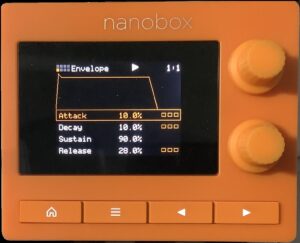After sampling Genos woodwind voices with 1010Music tangerine, I moved on to horns, strings and simple pads:
SeattleStrings mf 104 5 50 Live 1-127
Strings mf 0 118 49 Live 1-127
Strings 0 117 50 Live
VP Soft 104 0 90 Regular 1-127
DarkLight 104 3 90 Regular 1-127
MellowPad 0 117 96 Regular 1-127
ButterStrings 104 2 51 Regular 1-127
OrchHornsPad 104 11 62 Live 30-127, 1-127
SoftHorns 0 117 61 Live 1-127
MellowHorns 0 119 62 Regular 1-127
That’s enough to cover my basic needs (for liturgical music).
I dialed back all of the Genos EQ and effects, leaving a small amount of room reverb (Genos Real Room+ algorithm) for a bit of ambience. Yamaha “Live” voices are stereo, so I sampled them in stereo. [Duh.] The pads sound rather plain without Genos effects, but I’m adding modulation, delay and reverb on the tangerine itself.
I’m leaving quite a lot of head room when sampling Genos — a good thing. The Symplesound instruments have a bit of graininess which I chalk up to the high level of Symplesound’s multi-samples. The grain shows up when playing big, two-fisted chords and I think something is getting clipped somewhere. I haven’t experienced the same graininess with my own multi-samples, thanks to the head room.
Here are the tangerine voice parameter settings for the SeattleStringsMF preset:
Level +3.0dB
Pitch +0.00
Filter -30.0
Res 50.0%
Attack 10.0%
Decay 10.0%
Sustain 90.0%
Release 28.0%
Velocity 70.0%
Filter MOD VEL
Amount 15.0%
Filter MOD KEY
Amount 30.0%
The level adds a little overall boost. The filter settings bring in LPF through velocity and key scaling. As I said, these voices need sweetening. Reverb is added and I’m still working on chorus…
No filter envelope
My enthusiasm for tangerine has not waned. However, tangerine has a few shortcomings.
The biggest shortcoming is that the envelope does not modulate the filter. Yikes, this could be a deal-breaker for some people. Driving the filter is a pretty basic, needed capability and I hope that 1010Music add a solution in a future update.
What do those numbers mean?
You’ll notice that tangerine states many of its parameters as a percentage. Take the envelope parameters above, for example. Sustain and Velocity as a percentage are meaningful (i.e., percentage of full scale), but what the heck do the time-based parameters mean?
Percentage of what? There must be maximum attack, decay and release times. At the very least, 1010Music should state the maximum times and I’ll do the arithmetic. 1010Music state min and max for the LFO rate, for example.
1010Music need to improve the filter documentation, especially the way filter cut-off interacts with modulation. In particular, I’d like to know when to use negative values to tilt control curves the other way (e.g., key scaling or velocity scaling).
Effects
Based on Web comments, the first version of tangerine’s software implemented a more extensive set of delay and reverb parameters. Early adopters complained about the difficulty of dialing in delays and reverbs. 1010Music responded by “simplifying” the effect parameters.
I think they have gone too far. The reverb parameters are decay, pre-delay and damping — all expressed as percentages. Damping as a percentage makes sense. But, decay and pre-delay are time-based and a percentage is kind of meaningless. I often steal (borrow?) effect parameters from elsewhere and know that a 2.7 second reverb time and 20 millisecond initial delay will get me a large hall. tangerine doesn’t let me dial these basic values in directly and min/max time delays aren’t stated in the manual.
And — I confess — I’m at a total loss with the delay effect. [For now.] I haven’t been able to dial in a chorus effect. The maximum delay is stated, but I can’t get the delay short enough. Chorus needs a delay in the 10 to 50 millisecond range.
Hope these comments are helpful. Fingers are crossed for future updates from 1010Music.
My initial comments about 1010Music tangerine are here.
RTFM (update to an update)
Well, reading the manual can be beneficial. 🙂 You never know what you’ll find.
As to configuring a chorus effect, the manual does specify the maximum delay time: 4 seconds. Thus, the delay time needs to be around one percent (1%) in order to get a chorus-like delay time within 10 to 50 milliseconds.
The real bad news WRT chorus, however, is the lack of LFO modulation. The delay time should be LFO modulated in order to get a dynamic pitch shifting effect. I can hear a difference when delay is set in the 10 to 50 millisecond range, but it ain’t a true chorus without LFO mod. I may experiment with two slightly detuned layers and hear what happens.
So, that’s two big misses for tangerine:
- The envelope cannot modulate the filter cut-off.
- The LFO cannot modulate delay time.
Bummer! I hope 1010Music adds these modulation options in a future update. These options are quite essential and expected.
I stumbled across an essential detail about the filter parameter. Filter values between 0 and 100% (positive values) enable a high-pass filter (HPF). Negative filter values enable a low-pass filter (LPF). This explains why I had trouble tuning in the filter and modulation by ear alone. Information like this is someetimes a bear to pull out of the tangerine documentation.
The tangerine manual is pretty good by today’s standards. However, it needs better organization and an index. Some information — like parameter names, description, min and max values — should be collected into a single table. Believe it or not, Yamaha is quite good at organizing this sort of detailed information. See their “Data List” and Synthesizer Parameters PDFs.
Copyright © 2024 Paul J. Drongowski

